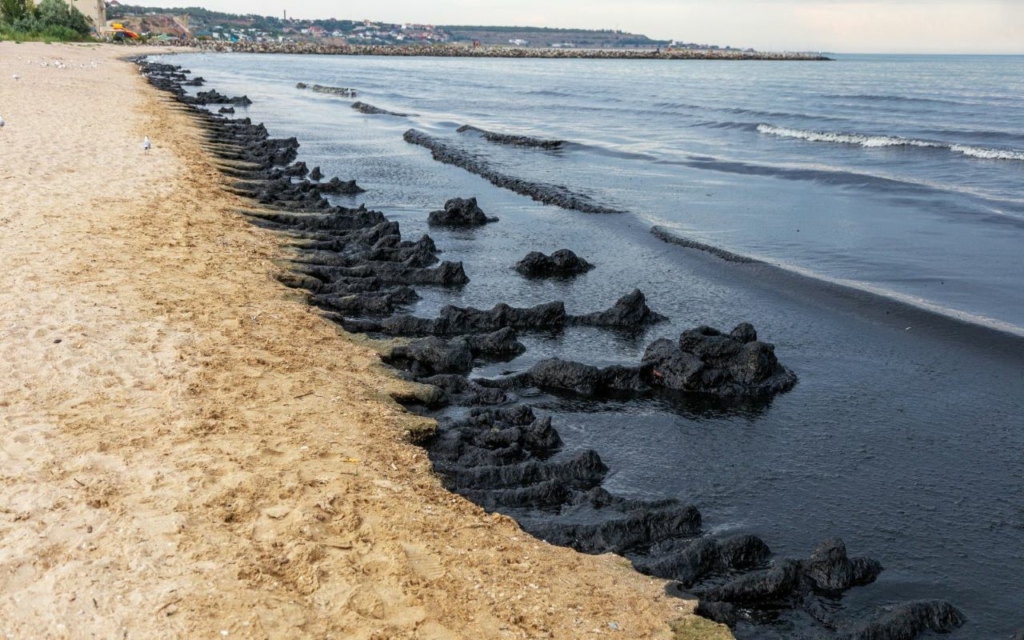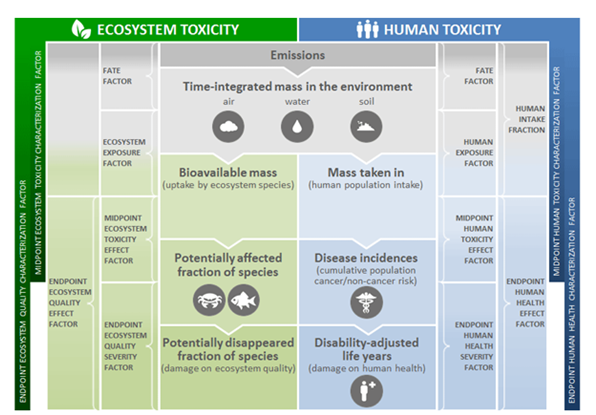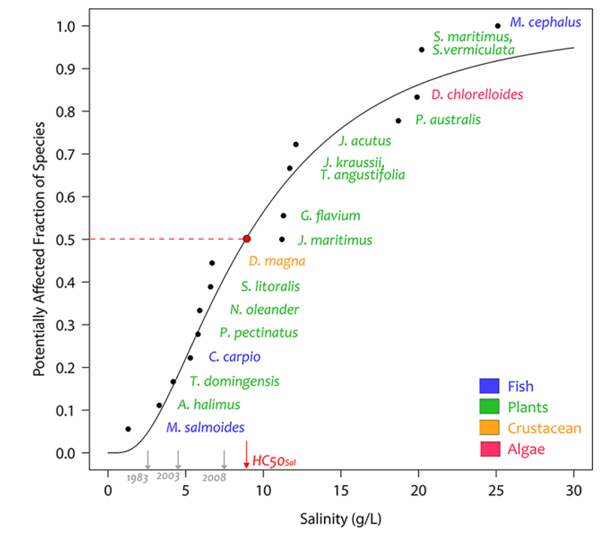Obscure impacts demystified: Ecotoxicity in aquatic ecosystems
It’s been a while since we last demystified an obscure impact category. This time, the spotlight is on ecotoxicity, mostly in aquatic ecosystems. How do methodologies in life cycle assessment (LCA) and life cycle impact assessment (LCIA) help us to understand how ecotoxicity acts within the environment? And why does it matter?
Toxic substances don’t stay nicely contained
Most of the available sources of water nowadays are somehow polluted: they contain microplastics, chemicals, or other substances that can be potentially toxic for life. When discussing the environment, the word ‘toxicity’ usually refers to harmful effects on humans, and ‘ecotoxicity’ to impacts on ecosystems. But how can we know if something is toxic, whether to the environment or to ourselves? And how can we measure it, especially ecotoxicity?
The environment is not a closed system. A variation in the conditions of one ecosystem can generate effects at a global level. However, to better understand and classify how the environment works, we usually divide it into compartments: air, soil and water.
LCIA methodologies attempt to model how an emission in one compartment is transferred to others, and what its ecotoxic effects are. For example, if some hazardous substance is emitted into the air from a factory, the substance will not only affect living organisms who breathe it in. It will also be transferred to the water due to the water cycle and to the soil due to the runoff. Once there, it may enter the food chain and affect the ecosystem in many ways. Effects on ecosystems are usually linked to human health impacts too, as the chemicals are potentially transferred to drinking water and food.
The different existing methods to assess ecotoxicity might address terrestrial or aquatic effects. In this article, we’ll try to unravel what is behind ecotoxicity for aquatic ecosystems.
Measuring impact: the characterization factors
It is not easy to monitor how substances behave in the environment. In LCIA, we use characterization factors (CFs) to transform emissions into impacts. For example, for global warming, the CFs are expressed in kg CO2-eq/kg of substance. But how can we transform emissions into impacts for ecotoxicity?
When modeling toxic behavior for aquatic environments, the CFs will help us to understand how the substance behaves in the water and what impacts the exposure of the water component to the toxic substance has. To translate emissions into impacts, we need to understand how the substance affects life.
Different LCIA methods use different approaches to express impacts. The USETox method, for example, measures ecotoxicity for freshwater ecosystems with the units ‘potentially disappeared fraction of species’ (PDF) or ‘potentially affected fraction of species’ (PAF), depending on whether we want to study species mortality or non-lethal effects.
What are characterization factors trying to tell us?
Models that describe how a substance might behave as ecotoxic need to account for three things: the fate, the exposure, and the effects. Together, this makes up the cause-effect pathways. Generally, we can sum up the models describing ecotoxic behavior with the equation below, which includes all these phenomena.
CF = FF · XF · EF

What this equation is telling us is, basically: when a substance is emitted, is it transferred to other compartments, or does it remain in the system (the fate factor FF)? If it remains in the system, how much contact is there between the substance and the living organisms of the ecosystem (the exposure factor XF)? Finally, once the substance is in contact with a living being, how much damage does it cause (the effect factor EF)?
The FF is expressed in units of time, as it represents the residence time of the substance in the compartment. For example, some metals rapidly oxidize when dissolved in water, so high emissions might not necessarily translate into high impacts as the residence of the toxic form in water is low.
The XF is unitless, as it represents the mass of pollutant absorbed by the organism per mass of substance present in the water. For ecotoxicity in aquatic environments, XF is linked with solubility. A substance that doesn’t dissolve in water might not be available for intake by organisms, and will have a lower impact than a soluble substance.
Finally, the EF translates the mass of substance into effects for the species present in the ecosystem. It gives information on the concentration of the substance that is necessary to generate effects on living beings. The units of the EF are affected species (thus, PAF or PDF) per concentration of pollutant.
The EF is the most difficult to determine, as it depends on species-specific biology, not just physics and chemistry. Substances don’t usually affect all the species in the same way: microbiota, algae, fish, etc. To build the EF, you need to characterize which species live in the environment, and how the pollutant under study affects each of these species individually. With all datapoints available, you compile the species sensitivity distribution (SSD). And then you choose a representative data point in the middle to calculate your effect factor (EF) – often the concentration hazardous to 50% of the species (HC50).
Why does ecotoxicity matter?
Ecotoxicity is important for its destabilizing effects on ecosystems. And, of course, ecotoxicity is always connected with effects on human health. In fact, ecotoxicity is linked to food security as well. Eventually, toxic substances in water can be transferred to animals such as molluscs, which are consumed by humans. They can also spread to drinkable water sources, to the soil through irrigation, and from the soil to crops. Controlling toxic impacts, therefore, improves food security and human health as well.
Some cases of severe ecotoxicity are now sadly famous. In one of the worst environmental catastrophes in the history of Canada, mercury was accidentally spilled into the Grassy Narrows River. The water was polluted and the Grassy Narrows First Nation people are suffering severe health effects even decades after the spill. Similar cases happened in Camelford (UK) because of an aluminum sulfate spill, the worst water poisoning in modern British history, and in the Gulf of Mexico, due to a dramatic oil spill.

What can we do to avoid ecotoxicity?
There are many things that companies, governments and institutions can do to avoid new tragedies like the ones that happened in the past and to reduce the emissions of toxic substances in the course of daily industrial and human activities. LCA and LCIA research is critical to provide these agents with the right information. If it is not known that a substance is toxic, or how toxic it is, this information can’t be introduced in LCA and LCIA models.
To reduce toxicity, it is essential to encourage companies and industries to carry out cleaner and more transparent practices and processes. For instance, through a wiser use of pesticides or more environmentally friendly agricultural practices. Consumers also have a role, by supporting companies that act to reduce their impact on the environment and are cautious of the substances they use. Finally, governments and international institutions need to increase their awareness of ecotoxicity and fund more research on the topic. Because the more we know, the more we can improve processes and products and ensure the safety of our water, our food, and our planet.
Limitations of ecotoxicity impact assessment and future outlook
The most mature methods to assess ecotoxicity are those for freshwater environments. For terrestrial and marine ecotoxicity, methods are under development. The research in the field shows promising improvement possibilities.
Some new substances and pollutants represent a challenge for the scientific community in environmental sciences. For example, the current effects of plastic pollution in aquatic environments (including oceans) are still unknown, and although research is being carried out, more investigation is needed. Other emerging pollutants include pharmaceutical substances, hormones, and chemicals present in beauty products. Even though we still have a long way to go, some methods like USEtox already have more than 40,000 substances in their characterization factor list! So we are in a good position to use our LCIA methods to ensure that our rivers, lakes, and oceans are safe.
We hope you enjoyed this article! Please let us know which other LCA indicators you’d like to read about and spread the word on social media using the hashtag #ObscureImpacts.
Read about other impact categories:
Alba Roibas Rozas
Analyst
Alba worked at PRé between 2022 and 2023. As a part of the Consultancy team, she collaborated with many LCA-related projects. She carried out projects in the field of biodiversity and corporate footprinting, and provided SimaPro trainings.

